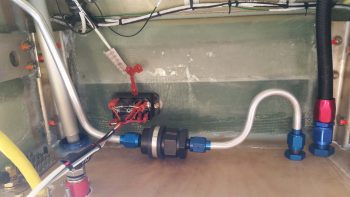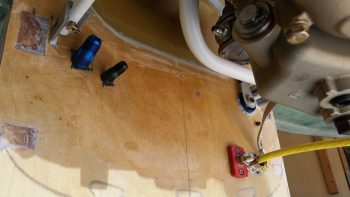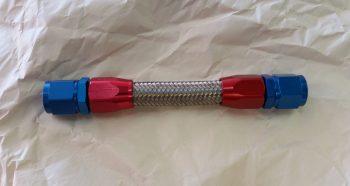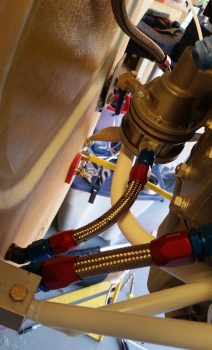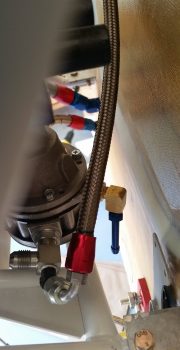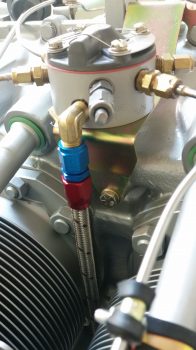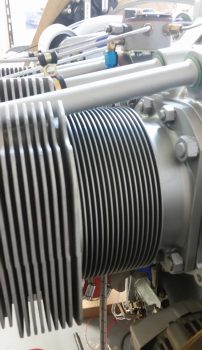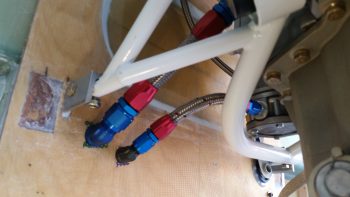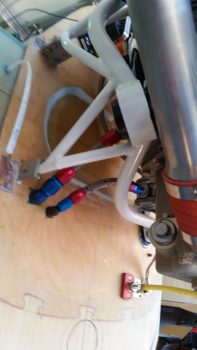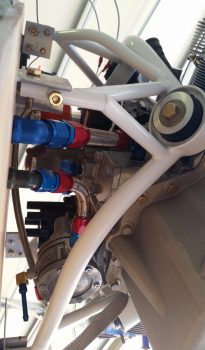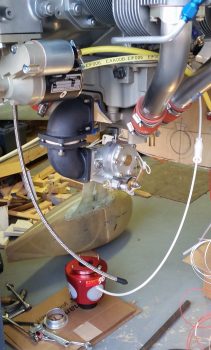I started off this morning inventorying a much-needed order from ACS that I just received. Included in the order was -20 sized Adel clamp for the fuel filter, that I immediately pressed into service. I cleaned the fuel lines fore and aft of the fuel filter then mounted them “permanently” (albeit servicing will occur…yes) to the filter, as well as permanently mounted the origin of the incoming line of the fuel filter (on left in pic below) at the FT-60 Red Cube fuel flow transducer.
I also received the 45° -6 AN bulkhead pass-thru for the fuel line and a 45° -8 AN bulkhead pass-thru for the oil heat return line. I finished drilling out those pass-thru holes to size and mounted the fittings through the firewall. As you can see I then mounted the fuel line and the oil heat return line to the 2 new firewall pass-thru fittings. To be clear, these pass-thru connections are NOT permanent installs at this point since they’ll need to be removed when the Fiberfrax and 6061 aluminum sheet cover get mounted to the firewall face.
Here’s a firewall shot of the 45° -8 AN pass-thru for the oil heat return line and the 45° -6 AN fuel line bulkhead pass-thru.
I then gathered up all the accouterments that I needed to make up some engine compartment stainless steel braided hoses with hose ends. Here’s the first hose I made, which is a -8 hose for the oil heat oil return line.
I then made up a -6 hose for the main fuel line feed to the fuel pump. One thing I honestly didn’t count on mentally was how SHORT these hoses would turn out based on the confined space of the engine compartment. I mean, really, the actual length of the hose component of the oil heat oil return line is only 3.7″ long! Crazy!
Since I had all the stuff out to make hoses I went ahead and terminated some ends ahead of time, like this hose end for the fuel pressure sensor line with the 90° hose end fitting on it. I was going to do the fuel pump side hose end on the fuel line that goes to the fuel injection servo, but realized I had a head space/timing issue (Browning 0.50 cal reference there) when I ordered the fitting and apparently the fine print said for PTFE hoses only…. oops and dammit! Ok, another hose end fitting order coming up!
I also attached a hose end fitting to the -8 oil line hose stock and –unrelated– installed the upper fuel spider hose end fitting to the -4 hose that will go from the fuel injection servo to the fuel spider.
Here you can see the hose peeking out the bottom of the engine. I’ll of course cut this hose to length and terminate it with a -4 AN hose end fitting once the fuel injection servo is set in its final configuration.
I know the bottom shot is a little blurry, but it’s a decent view of the 2 hoses I just made up today.
And another one from below the engine, at the bottom of the firewall.
I also worked for a couple of hours in assessing the bottom engine area, to include the location of the oil heat sump feed line, the oil drain valve, the fuel injection servo, air intake elbows, and the RAM air intake. Believe me, there was a lot of musical chairs going on in setting up the configuration (read: major configuration changes) to even begin to work. I even had to pull out the lower cowling and mock install it a number of times to check for clearances. Not surprisingly, there is just so LITTLE space for everything to get crammed in there, and I had to resort to a myriad of small, constant changes to even being to get close to the configuration I want.
One immediate change (that I was allowing for) that happened after ascertaining the amount of clearance between the lower cowling and the cold air intake tubes is that I moved the alternator and starter power wires to traverse the engine heading forward on the inboard side of the cold air intake tubes vs the outboard/lower side.
So . . . the air induction system should become much clearer over the next week and I will definitely share more as it all unfolds.
I’ll be heading down to Marco’s for a very short 2-day trip and when I return I really want to finalize the firewall aft configurations and get the engine back off the fuselage and onto it’s engine stand. Moreover, I plan on starting on the canopy and nose at the end of next week.

